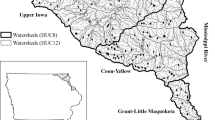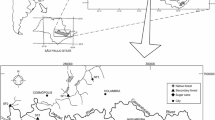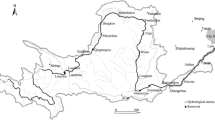Abstract
The objective of this study was to develop an index of biological integrity (IBI) for national-level monitoring of watersheds as an ecosystem health assessment methodology for the South Korean government. A 10-metric IBI model (IBIKW) was developed for watershed management and then applied to 76 streams in four major watersheds in Korea. The model assessments showed that 32.9% of all streams were judged to be in ‘excellent–good’ condition, whereas 67.1% were in ‘fair–poor’ condition, indicating severely impaired ecological health. Nutrient analyses of stream water revealed a two- to fivefold increase in nutrient and biological oxygen demand (BOD) levels in urban- and cropland-dominant streams compared to forest-dominant streams. The guild structure within the watersheds indicated that tolerant species were predominant in severely degraded regions (BOD > 6 mg L−1), and sensitive species were distributed in regions with BOD < 2 mg L−1. Factors affecting ecosystem health (IBIKW scores) included chemical water quality parameters, physical habitat parameters and land use around the stream. In particular, land use was one of the major factors influencing ecosystem health, as indicated by the strong relationships between the percentages of urban and forest streams and the IBIKW scores. The integrated ecosystem health assessment technique developed here can be applied for both regular bioassessments and post-restoration assessments.













Similar content being viewed by others
References
Adams, S. M., Greeley, M. S., & Ryon, M. G. (2000). Evaluating effects of contaminants on fish health at multiple levels of biological organization: Extrapolating from lower to higher levels. Human & Ecological Risk Assessment, 6, 15–27.
Allan, J. D., Erickson, D. L., & Fay, J. (1997). The influence of catchment land use on stream integrity across multiple scales. Freshwater Biology, 37, 149–161.
An, K.-G., Jung, S.-H., & Choi, S.-S. (2001). An evaluation on health conditions of Pyong-Chang river using the index of biological integrity (IBI) and qualitative habitat evaluation index (QHEI). Korean Journal of Limnology, 34, 153–165.
An, K.-G., Lee, J. Y., Bae, D. Y., Kim, J. H., Hwang, S. J., Won, D. H., et al. (2006). Ecological assessments of aquatic environments using a multimetric model in major nationwide stream watersheds. Journal of Korean Water Quality, 22(5), 796–804.
An, K.-G., Lee, J.-Y., Kumar, H. K., Lee, S.-J., Hwang, S.-J., Kim, B.-H., et al. (2010). Control of algal scum using top-down biomanipulation approaches and ecosystem health assessments for efficient reservoir management. Water, Air, and Soil Pollution, 205, 3–24.
APHA. (1985). Standard methods for the examination of water and waste water (16th ed.). New York: American Public Health Association.
Barbour, M. T., Gerritsen, J., Snyder, B. D., & Stribling, J. B. (1999). Rapid bioassessment protocols for use in streams and wadeable rivers: Periphyton, benthic macroinvertebrates and fish. EPA 841-B-99-002 (2nd ed.). Washington, DC: US Environmental Protection Agency, Office of Water.
Barbour, M. T., Swietlik, W. F., Jackson, S. K., Courtemanch, D. L., Davies, S. P., & Yoder, C. O. (2000). Measuring the attainment of biological integrity in the USA: A critical element of ecological integrity. Hydrobiologia, 422(423), 453–464.
Bartholow, J. M. (1989). Stream temperature investigations: field and analytical methods. Instream flow information paper 13. Biological Report 89 (17). Washington, DC: Fish and Wildlife Service, US Department of the Interior.
Burcher, C. L., Valett, H. M., & Benfield, E. F. (2007). The land-cover cascade: Relationships coupling land and water. Ecology, 88, 229–242.
Cooper, M. J., Uzarski, D. G., Burton, T. M., & Rediske, R. R. (2006). Macroinvertebrate community composition, chemical/physical variables, land use and cover, and vegetation types within a Lake Michigan drowned river mouth wetland. Aquatic Ecosystem Health and Management Society, 9(4), 463–479.
Crumpton, W. G., Isenhart, T. M., & Mitchell, P. D. (1992). Nitrate and organic N analyses with second-derivative spectroscopy. Limnology and Oceanography, 37, 907–913.
Dauwalter, D. C., & Jackson, J. R. (2004). A provisional fish index of biotic integrity for assessing Ouachita Mountain streams in Arkansas, USA. Environmental Monitoring and Assessment, 91, 27–57.
Deacon, J. R., Soule, S. A., & Smith, T. E. (2005). Effects of urbanization on stream quality at selected sites in the seacoast region in New Hampshire, 2001–2003. USGS Scientific Investigations Report, 2005-5103.
DIN 38410. (1990). Biological–ecological analysis of water (group M); determination of the saprobic index (M2). German standard methods for the examination of water, p. 10. Part 2, waste water and sludge.
Dodds, W. K. K., & Welch, E. B. (2000). Establishing nutrient criteria in streams. Journal of the North American Benthological Society, 19(1), 186–196.
Fausch, K. D., Karr, J. R., & Yant, P. R. (1984). Regional application of an index of biotic integrity based on stream fish communities. Transactions of the American Fisheries Society, 113, 39–55.
Fausch, K. D., Lyons, J., Karr, J. R., & Angermeier, P. L. (1990). Fish communities as indicators of environmental degradation. American Fisheries Society Symposium, 8, 123–144.
Ganasan, V., & Hughes, R. M. (1998). Application of index of biological integrity (IBI) to fish assemblages of the rivers Khan and Kshipra (Madhya Pradesh), India. Freshwater Biology, 40, 12–18.
Hamilton, K., & Bergersen, E. P. (1984). Methods to estimate aquatic habitat variables. Environmental evaluation project no. DPTS-35-9. Denver: Bureau of Reclamation, Denver Federal Center.
Hughes, R. M., & Oberdorff, T. (1999). Applications of IBI concepts and metrics to waters outside the United States and Canada. In T. P. Simon (Ed.), Assessing the sustainability and biological integrity of water resources using fish assemblages (pp. 79–93). Boca Raton: Lewis.
Hughes, R. M., Heiskary, S. A., Mathews, W. J., & Yoder, C. O. (1994). Use of ecoregions in biological monitoring. In S. L. Loeb & A. Spacie (Eds.), Biological monitoring of aquatic systems (pp. 125–151). Chelsea: Lewis.
Hugueny, B. S., Camara, B., Samoura, B., & Magassouba, M. (1996). Applying an index of biotic integrity based on communities in a West African river. Hydrobiologia, 331, 71–78.
Judy, R. D., Seeley, P. N., Jr., Murray, T. M., Svirsky, S. C., Whitworth, M. R., & Ischinger, L. S. (1984). National fisheries survey, vol. 1. Technical report: initial findings. FWS/OBS-84/06. Washington, DC: US Fish and Wildlife Service.
Kamdem-Toham, A., & Teugels, G. G. (1999). First data on an index of biotic integrity (IBI) based on fish assemblages for the assessment of the impact of deforestation in a tropical West African system. Hydrobiologia, 397, 29–38.
Karr, J. R. (1981). Assessments of biotic integrity using fish communities. Fisheries, 6, 21–27.
Karr, J. R. (1991). Biological integrity: A long-neglected aspect of water resource management. Ecological Applications, 1, 66–84.
Karr, J. R. (1999). Defining and measuring river health. Freshwater Biology, 41, 221–234.
Karr, J. R., & Chu, E. W. (1999). Restoring life in running waters: Better biological monitoring. Washington, DC: Island Press.
Karr, J. R., & Chu, E. W. (2000). Sustaining living rivers. Hydrobiologia, 422(423), 1–14.
Karr, J. R., & Dionne, M. (1991). Designing surveys to assess biological integrity in lakes and reservoirs, in biological criteria. In Research and regulation—proceedings of a symposium, EPA-440/5-91-005 (pp. 62–72). Washington, DC: US EPA, Office of Waters.
Karr, J. R., Fausch, K. D., Angermeier, P. L., Yant, P. R., & Schlosser, I. J. (1986). Assessing biological integrity in running water: A method and its rationale. Special publication 5. Champaign: Illinois National History Survey.
Kelly, M. G., & Whitton, B. A. (1995). The trophic diatom index: A new index for monitoring eutrophication in rivers. Journal of Applied Phycology, 7, 433–444.
Kelly, M. G., Cazaubon, A., Coring, E., Dell’Uomo, A., Ector, L., Goldsmith, B., et al. (1998). Recommendations for the routine sampling of diatoms for water quality assessments in Europe. Journal of Phycology, 10, 215–224.
Kim, I. S. (1997). Illustrated encyclopedia of fauna and flora of Korea. Freshwater fishes (Vol. 37, pp. 1–629). Seoul: Ministry of Education.
Kim, I. S., & Park, J. Y. (2002). Freshwater fishes of Korea. Seoul: KyoHak.
Kleynhans, C. J. (1999). The development of a fish index to assess the biological integrity of South African rivers. Water SA, 25(3), 265–278.
Koizumi, N., & Matsumiya, Y. (1997). Assessment of stream fish habitat based on index of biotic integrity. Bulletin of Japanese Society of Fisheries Oceanography, 61, 144–156.
Lafferty, B. (1987). A procedure for evaluating buffer strips for stream temperature protection under the Forest Practices Act. In: Managing Oregon’s riparian zone for timber, fish, and wildlife. Technical bulletin, vol. 514 (pp. 70–77). New York: National Council for Air and Stream Improvement.
Lang, C., & Reymond, O. (1995). An improved index of environmental quality for Swiss rivers based on benthic invertebrates. Aquatic Sciences, 57(2), 172–180.
Lang, C., l’Eplattenier, G., & Reymond, O. (1989). Water quality in rivers of Western Switzerland: Application of an adaptable index based on benthic invertebrates. Aquatic Sciences, 51(3), 224–234.
Legendre, P., & Legendre, L. (1998). Numerical ecology (developments in environmental modelling) (2 Englishth ed.). Amsterdam: Elsevier.
Lyons, J., Navarro-Perez, S., Cochran, P. A., Santana, E., & Guzman-Arroyo, M. (1995). Index of biotic integrity based on fish assemblages for the conservation of streams and rivers in west-central Mexico. Conservation Biology, 9, 569–584.
Lyons, J., Gutierrez-Hernandez, A., Diaz-Pardo, E., Soto-Galera, E., Medina-Nava, M., & Pineda-Lopez, R. (2000). Development of a preliminary index of biotic integrity (IBI) based on fish assemblages to assess ecosystem condition in the lakes of central Mexico. Hydrobiologia, 418, 57–72.
Maezono, Y., & Miyashita, T. (2004). Impact of exotic fish removal on native communities in farm ponds. Ecological Research, 19, 263–267.
McCune, B., & Mefford, M. J. (1999). PC-ORD. Multivariate analysis of ecological data. Version 4.0. Gleneden Beach: MjM Software.
Morris, C. C., Stewart, P. M., & Simon, T. P. (2007). Development of an index of biotic integrity for a southeastern coastal plain watershed, USA. Journal of the American Water Resources Association, 43(2), 295–307.
Nelson, J. S. (1994). Fishes of the world (3rd ed.). New York: Wiley.
Ohio EPA. (1987). Biological criteria for the protection of aquatic life. Users manual for biological field assessment of Ohio surface waters, vol. II. Columbus: Ohio Division of Water Quality Monitoring and Assessment, Surface Water Section.
Ohio, E. P. A. (1989). Biological criteria for the protection of aquatic life, Vol. III. Standardized biological field sampling and laboratory method for assessing fish and macroinvertebrate communities. Columbus: Ohio EPA Division of Water Quality Monitoring and Assessment, Surface Water Section.
Plafkin, J. L., Barbour, M. T., Porter, K. D., Gross, S. K., & Hughes, R. M. (1989). Rapid assessment protocols for use in streams and rivers: benthic macroinvertebrates and fish. EPA/444/4-89-001. Washington, DC: US Environmental Protection Agency, Office of Water Regulations and Standards.
Prepas, E. E., & Rigler, F. A. (1982). Improvements in qualifying the phosphorus concentration in lake water. Canadian Journal of Fisheries and Aquatic Sciences, 39, 822–829.
Pyron, M., Lauer, T. E., LeBlanc, D., Weitzel, D., & Gammon, J. R. (2008). Temporal and spatial variation in an index of biological integrity for the middle Wabash River, Indiana. Hydrobiologia, 600, 205–214.
Rankin, E. T., & Yoder, C. O. (1999). Adjustments to the index of biotic integrity: a summary of Ohio experiences and some suggested modifications. In T. P. Simon (Ed.), Assessing the sustainability and biological integrity of water resources using fish communities. Boca Raton: CRC.
Rossano, E. M. (1996). Diagnosis of stream environments with index of biological integrity. Tokyo: Sankaido.
Sanders, R. E., Milter, R. J., Yoder, C. O., & Rankin, E. T. (1999). The use of external deformities, erosion, lesions, and tumors (DELT anomalies) in fish assemblages for characterizing aquatic resources: a case study of seven Ohio streams. In T. P. Simon (Ed.), Assessing the sustainability and biological integrity of water resources using fish communities (pp. 225–245). Boca Raton: CRC.
Simon, T. P. (2003). Biological response signatures: Indicator patterns using aquatic communities. Boca Raton: CRC.
Soto-Galera, E., Díaz-Pardo, E., López-López, E., & Lyons, J. (1998). Fish indicator of environmental quality in the Río Lerna Basin, México. Aquatic Ecosystem Health & Management, 1, 267–276.
SPSS. (2004). SPSS 12.0 KO for Windows. Atlanta: Apache Software Foundation.
Steedman, R. J. (1988). Modification and assessment of an index of biotic integrity to quantify stream quality in southern Ontario. Canadian Journal of Fisheries and Aquatic Sciences, 45, 492–501.
Strahler, A. N. (1957). Quantitative analysis of watershed geomorphology. American Geophysical Union Transactions, 38, 913–920.
ter Braak, C. J. F. (1987). The analysis of vegetation–environment relationships by canonical correspondence analysis. Vegetatio, 69, 69–77.
Tong, S. T. Y. (2001). An integrated exploratory approach to examining the relationships of environmental stressors and fish responses. Journal of Aquatic Ecosystem Stress and Recovery, 9, 1–19.
US, E. P. A. (1983). Technical support manual: Waterbody surveys and assessment for conducting use attainability analyses. Washington, DC: US EPA Office of Water Regulations and Standards.
US EPA. (1993). Fish field and laboratory methods for evaluating the biological integrity of surface waters. EPA 600-R-92–111. Cincinnati: US Environmental Monitoring Systems Laboratory–Cincinnati, Office of Modeling, Monitoring Systems and Quality Assurance.
US EPA. (1994). Environmental monitoring and assessment program: integrated quality assurance project plan for the surface waters resource group. 1994 activities, Rev. 2.00. EPA 600/X-91/080. Las Vegas: US EPA.
US EPA. (1999). Rapid bioassessment protocols for use in streams and wadeable rivers. EPA 841-B-99-002 (2nd ed.). Washington, DC: US EPA, Office of Water.
US EPA. (2002). Biological assessments and criteria. EPA 822-F-02-006. Washington, DC: US EPA, Office of Water.
Wang, L., Brenden, T., Seelbach, P., Cooper, A., Allan, D., Clark, R. J., et al. (2008). Landscape based identification of human disturbance gradients and reference conditions for Michigan streams. Environmental Monitoring and Assessment, 141, 1–17.
Yoder, C. O., & Rankin, E. T. (1998). The role of biological indicators in a state water quality management process. Environmental Monitoring and Assessment, 51, 61–88.
Zhu, D., & Chang, J. (2008). Annual variations of biotic integrity in the upper Yangtze River using an adapted index of biotic integrity (IBI). Ecological Indicators, 8, 564–572.
Author information
Authors and Affiliations
Corresponding author
Rights and permissions
About this article
Cite this article
Choi, JW., Kumar, H.K., Han, JH. et al. The Development of a Regional Multimetric Fish Model Based on Biological Integrity in Lotic Ecosystems and Some Factors Influencing the Stream Health. Water Air Soil Pollut 217, 3–24 (2011). https://doi.org/10.1007/s11270-010-0563-1
Received:
Accepted:
Published:
Issue Date:
DOI: https://doi.org/10.1007/s11270-010-0563-1




